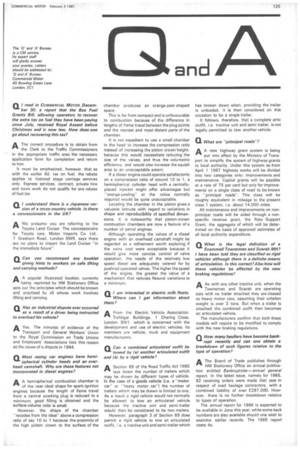Q Most racing car engines have hemispherical cylinder heads and
Page 127

If you've noticed an error in this article please click here to report it so we can fix it.
an overhead camshaft. Why are these features not incorporated in diesel engines?
AA hemispherical combustion chamber is
of the near-ideal shape for spark-ignition engines because the length of flame travel from a central sparking plug is reduced to a minimum, good filling is obtained and the surface-volume ratio is small.
However, the shape of the chamber "recedes from the ideal" above a compression ratio of say 10 to 1 because the proximity of the high piston crown to the surface of the chamber produces an orange-peel-shaped space.
This is far from compact and is unfavourable to combustion because of the difference in lengths of flame travel between the plug points and the nearest and most distant parts of the chamber.
It is not expedient to use a small chamber in the head to increase the compression ratio instead of increasing the piston crown height, because this would necessitate reducing the size of the valves, and thus the volumetric efficiency, and would also increase the squish area to an unacceptable extent.
If a diesel engine could operate satisfactorily on a compression ratio of around 10 to 1, a hemispherical cylinder head with a centrallyplaced injector might offer advantages but "orange-peeling" at the ratios normally required would be quite unacceptable.
Locating the chamber in the piston gives a valuable latitude with regard to variations in shape and reproducibility of specified dimensions. It is noteworthy that piston-crown combustion chambers are now a feature of a number of petrol engines.
Although operating the valves of a diesel engine with an overhead camshaft might be regarded as a refinement worth exploring if the extra cost were acceptable because it would give more concise control of valve operation, the needs of the relatively tow speed diesel are adequately catered for by pushrod-operated valves. The higher the speed of the engine, the greater the value of a mechanism that reduces flexural variations to a minimum.
















































































































































































